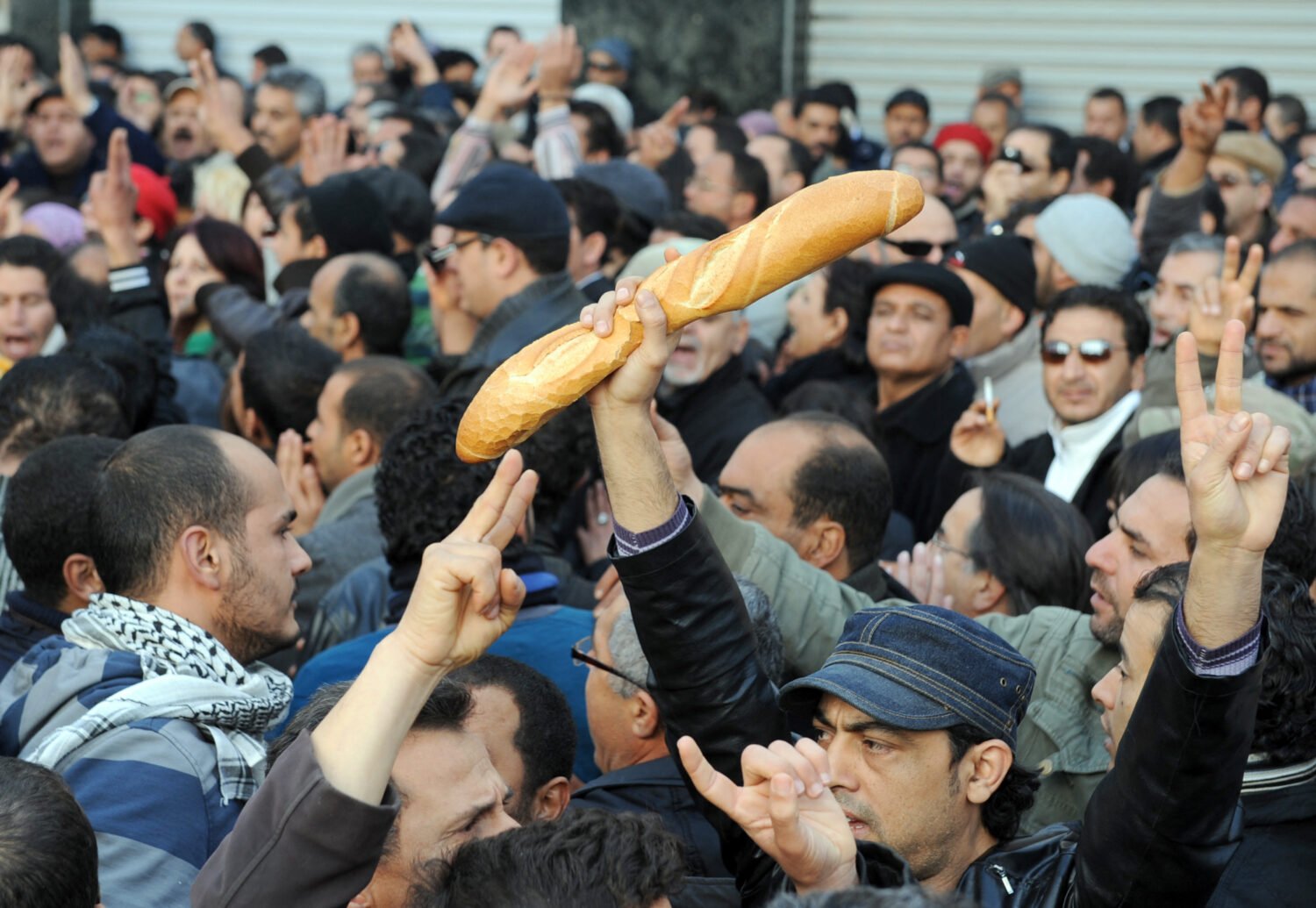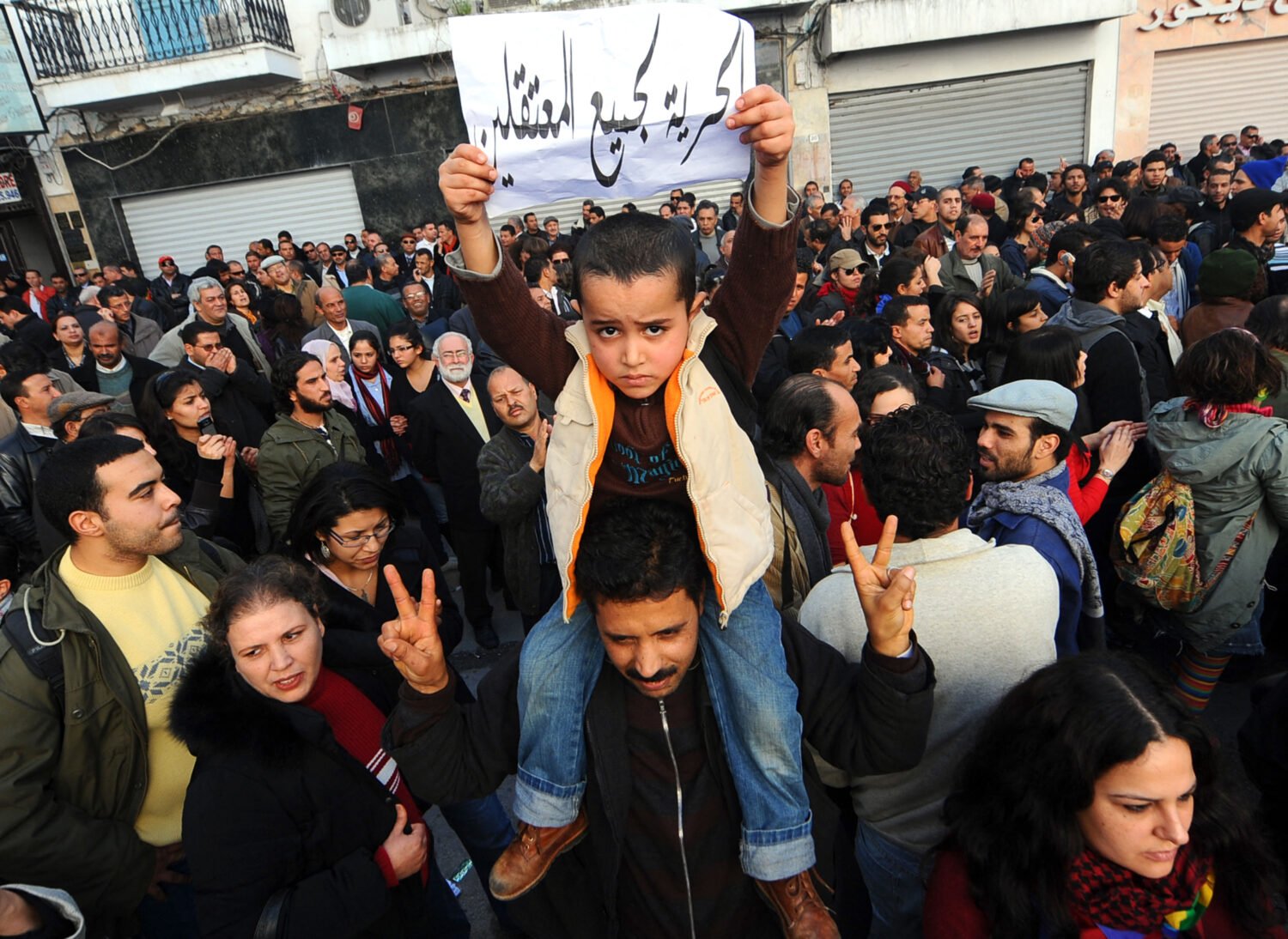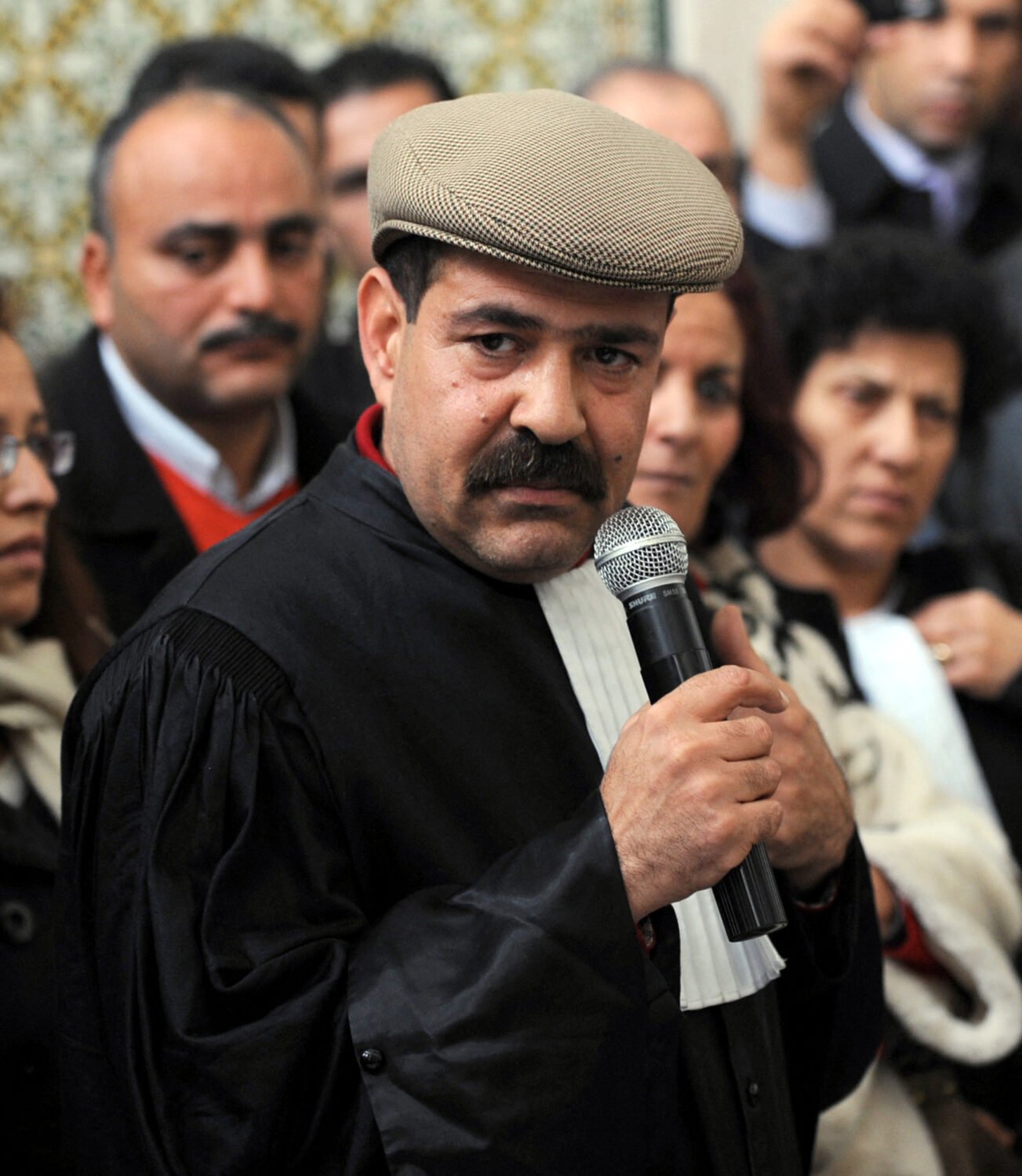The political disillusion with the government of Zine El Abidine Ben Ali came to a head in 2010. Anger over repression, inequality and poverty led Tunisians to take to the streets.

Author: C.R. Pennell, former Al-Tajir Lecturer in the History of Islam and the Middle East, University of Melbourne, Australia
Edited by: Erik Prins
Tunisia under Ben Ali: repression and monopolisation
The Ben Ali regime had a benign façade, with a parliamentary system, including regular elections. Gender quotas within the ruling Rassemblement Constitutionnel Démocratique (RCD), Ben Ali’s party, produced a higher proportion of female deputies in parliament (27.6 per cent) than any other country in the region – and indeed the United States and parts of Europe.
This disguise of democratisation allowed the regime to tolerate, and incorporate moderate opposition groups and allow trade unions, human rights organisations and associations of lawyers to function to a limited extent. But it also acted as a cover to crush political parties deemed threatening, such as Ennahda, the main Islamist party.
Ben Ali turned a fierce repression on activists, resulting in many arrests and prisoners, including women, who were often tortured and abused. While the government depended heavily on the police and security forces to keep its grip on power, it marginalised the army to impede any threat of a coup.
The corruption within the regime, one of the issues Tunisians would later protest against, began with the family of the president, who controlled large parts of society. Ben Ali’s wife, Leila Trabelsi, presided over numerous relief agencies, while his children controlled large business interests including banks, telecommunications, and media outlets.
This alienated large sectors of the bourgeoisie, who had benefited from economic growth in the past but now found themselves excluded by the family’s monopoly over the economy. In addition, family ownership made it impossible for media channels to express dissent.
The wealth of the regime’s elite contrasted starkly with the poverty and unemployment rates which spiked in the early 2000s. The global financial crisis of 2008 brought increased unemployment across Tunisia, and fuel and food prices soared in 2010, causing small riots. The worst problems were in the interior of Tunisia, particularly the northwest and the south, which were even more underdeveloped than the rest of the country. In the summer of 2010, there were protests at Ben Guerdane, near the Libyan frontier.
Source: Worldbank/ILO
Suicide sparks wildfire of protests
The simmering fire of protest against Ben Ali’s authoritarian regime was further ignited when on 17 December 2010, a poor street fruit seller, Mohammed Bouazizi set himself alight by pouring petrol over himself. Humiliating treatment by the police – a policewoman slapped Bouazizi across the face in a dispute over his vendor’s licence -led him to commit suicide. Bouazizi was from Sidi Bouzid, a poor town in the middle of the country where some 55 per cent of Tunisians with a university degree were unemployed.
His protest and suicide by fire caught the attention of Tunisians and protests spread throughout the country – first to other rural places, such as Kasserine, close to the border with Algeria, and then to the capital Tunis, where lawyers and trade unionists joined in.
The regime handled the crisis badly, even from a public relations point of view. After Ben Ali visited the dying Bouazizi in hospital, the government released a photograph of the event in which the expressions of disgust on the faces of the doctors were clear.
Protests that had first been localised in the south spread throughout Tunisia, and increasingly involved a wide cross-section of society, including professionals such as lawyers, doctors, and teachers. They demanded economic change and political rights.

The flight of Ben Ali
On 14 January 2011, Ben Ali promised that he would not run for the presidency again in 2014 and that there would be legislative elections within six months. While he announced press freedom and reduced the prices of basic commodities, he also imposed a state of emergency, including a ban on public assemblies of more than three people. The Tunisian General Labour Union (Union Générale Tunisienne du Travail, UGTT) called a general strike and the army refused to fire on demonstrators. Ben Ali and his wife Leila fled to Saudi Arabia.
Members of the Ben Ali family were arrested and a warrant for the ex-president’s arrest was issued. Yet despite the collapse of the ruling family, the state structures survived. The Tunisian state that President Ben Ali had corrupted had reasserted itself.
After Ben Ali fled, Prime Minister Mohammed Ghannouchi briefly took over the presidency before handing it to the speaker of parliament, Fouad Mebazza. Ghannouchi remained prime minister in a new national unity government formed on 17 January. Although he included historic opponents of the old RCD regime he had served, he reserved key ministries (e.g., foreign affairs, interior, defence) for members of the RCD, which exacerbated public anger.
Protests continued, with the support of the UGTT. Under pressure from the Tunisian street, Ghannouchi was forced to begin the process of dismantling the old order. As a result, he reshuffled a number of ministerial positions and announced a new government on 27 January.
Provisional governments
The new government was no longer dominated by the old ruling party, the RCD. In addition, it replaced all provincial governors. However, the government lasted exactly a month. Then, on 27 February, Ghannouchi himself resigned. Beji Caid Essebsi took over as interim prime minister, and elections were announced. Even so, protesters continued their demonstrations against the provisional government as they complained that the old guard of Ben Ali’s regime was still exercising power.
Essebsi had been a minister several times under President Habib Bourguiba and was speaker of parliament during the first years of Ben Ali’s rule. He was also a high-ranking official in the RCD. Yet he had been out of the spotlight for years when the revolution occurred.
Once Essebsi had become prime minister, he dissolved the RCD along with the secret police that had underpinned it, and legalised Ennahda. Then he suspended the constitution, established an independent electoral body (ISIE), and set the date for the election of a National Constituent Assembly (NCA, hereafter ‘Assembly’), Tunisia’s parliament. The new electoral code, promulgated in May 2011, imposed a nearly even gender split between candidates for the Constituent Assembly elections which would write a new constitution.
The new government had to deal with the crisis in Libya, maintaining connections with both Gaddafi and his armed opponents, while facing the influx of a million refugees and the smuggling of weapons. Essebsi was able to appease the UGTT and those participating in the Kasbah sit-ins, thus decreasing strikes and protests.
Meanwhile, the rebellion in Tunisia against Ben Ali had spread to other Arab countries, sparking a region-wide movement known as the ‘Arab Spring’. Rich and powerful countries, such as Algeria, Saudi Arabia and other Gulf states were worried that the Tunisian revolution would allow a resurgence of Islamism in their own countries.
Islamic extremism did indeed develop in Tunisia: in May 2011, a colonel and his soldiers were killed near the Algerian border. Shortly afterwards, a movie theatre was vandalised for showing a movie that militants considered anti-Islamic, and the same motive lay behind an attack later that year against Nessma TV’s headquarters, after it broadcast the film Persepolis. Some observers saw this violence as a signal of a coming conflict between the advocates of an Islamist Tunisia and those supporting a secular nation.
Ennahda thrived. Although it had been illegal for a long period under Ben Ali, it had an impressive social base and grassroots organisation and was better funded than other parties. As the oldest opposition movement in Tunisia, it had unassailable credentials. When the first free and fair elections in the country’s history were finally held on 23 October 2011, Ennahda emerged as the largest party and took 89 of the 217 seats, with 41 per cent of the vote. Fifty-nine women were elected to the Assembly, forming 27 per cent of deputies. Ennahda appointed its secretary general, Hamadi Jebali, as prime minister on 24 December 2011.
Because Ennahda did not have a majority, it formed a coalition with two secular parties, the social-democratic party Ettakatol, whose leader Mustapha Ben Jaafar became speaker of the Assembly; and the centre-left Congrès pour la République (CPR). Moncef Marzouki, former leader of the CPR, became president of the Republic of Tunisia on 13 December 2011. This coalition came to be known as the Troika. Hamadi Jebali, the secretary general of Ennahda became prime minister.
Ennahda in power
Although the government led by Jebali was a coalition, some opponents regarded the large number of ministers hailing from Ennahda as a way to reward the party’s militants. Others believed it to be a strategy used by Ennahda to understand the functioning of the state from within, thus giving it better control of the government in the future.
Prime Minister Jebali and President Marzouki clashed several times, notably when the government, against the orders of President Marzouki, decided to hand over Gaddafi’s last prime minister, Baghdadi Ali Mahmudi, who was under arrest in Tunis, to the new Libyan authorities in mid-2012. Relations with Algeria, Saudi Arabia, and the UAE were also tense under the new regime. The rulers also decided to cut the country’s relations with Baathist Syria.
Social demands grew during the Jebali period, along with rising commodity prices. Salafists, allegedly protected by Ennahda, grew more vocal, especially under the banner of Ansar al-Sharia. More dangerous, though, was the insurgency that began in the Chaambi Mountains, on the Algerian border, where suspected jihadi Salafists began to plant bombs and kill soldiers. The movement had existed under Ben Ali, but at that time the militants had been systematically crushed and their operations limited, apart from the 2002 synagogue bombing and the 2007 Soliman gun battles.
In 2012, the Leagues for the Protection of the Revolution (LPR) emerged, a coalition that included Islamists and jobless youth. This violent group was close to Ennahda and the CPR and went on to organise many attacks on the UGTT headquarters, opposition parties, and civil-society organisations. In October 2012, it assassinated Lotfi Nagdh, the coordinator of the newly-formed Nidaa Tounes in Tataouine in the far south of the country.
Nidaa Tounes was a secular political party founded by former Prime Minister Beji Caid Essebsi in June 2012. Nidaa quickly became the main rival of Ennahda, and in December 2012 it allied with liberal and centre-left parties al-Joumhouri and al-Massar in the Union for Tunisia. On the left, twelve left-wing and pan-Arab parties coalesced under the banner of al-Jabha al-Shaabiya (Popular Front) in August 2012.
In September 2012, Ansar al-Sharia attacked the US Embassy and the American School in Tunis, imitating the attacks on the US diplomatic compound and its CIA annex in Benghazi, Libya.
The Rough Road to a New Constitution
Against this background, the process of formulating a constitution was extremely difficult. When it started in January 2012, it was supposed to take only six months but there were so many points of disagreement between the Troika and the opposition, particularly over the question of the role of religion in the state, that it took far longer.
In mid-2012, a political solution outside parliament began to emerge, under the auspices of the UGTT, the Tunisian General Labour Union. The UGTT called for national reconciliation. At first, this proposal was not very effective because of the historic mistrust between the UGTT and Ennahda, but when the UGTT threatened to call a general strike, Ennahda agreed to a dialogue if other civil society organisations took part.
The Union’s leadership linked up three other civil society organisations – the employers’ organisation, the Tunisian Confederation of Industry, Trade and Handicrafts (UTICA), the Tunisian Human Rights League (LTDH) and the Tunisian Order of Lawyers (Ordre National des Avocats de Tunisie). The trade union federation and the employers’ organisation used their muscle by announcing a social contract that would allow them to work together to break the circle of violence and political stalemate. They formed the Tunisian National Dialogue Quartet to act as mediators.
This did not solve the political crisis immediately. The turmoil continued in the first part of 2013. On 6 February, Chokri Belaid, a leader of a secular leftist party, the Democratic Patriots’ Movement, was shot dead in front of his house. Hundreds of thousands of people took to the streets, calling on Ennahda to resign. Opposition members of the Assembly then withdrew from the body. On 19 February 2013, Prime Minister Jebali resigned and handed power to his minister of Interior and Ennahda’s third-in-command, Ali Laarayedh (b. 1955).
The Laarayedh government was half-Ennahda, half-technocratic. Key ministries went to technocrats, and the new prime minister vowed to fight terrorism. But the shuffle also removed Abdelkrim Zbidi (b. 1950), the minister of defence, who had served as a minister under Ben Ali and maintained good relations with General Rachid Ammar (b. 1947 or 1948), the chief of staff of the armed forces.

General Ammar retired four months later, triggering a major change among the high-ranking officers of the army and the police. Some analysts related this change to the events in Egypt (summer 2013), and officials spoke of a failed coup attempt (of which there has, as yet, been no investigation). The opposition became more suspicious of Ennahda’s goals after this change.
Then, in July 2013, Mohamed Brahmi, a member of the Popular Front, became the second leftist to be assassinated that year. In response, just under a third of the Assembly members withdrew in protest. They called on Ennahda to resign, accusing it of tolerating violent Islamists and thereby failing to guarantee public security. Some members of the Assembly even called for it to be dissolved and the constitutional process to stop. A bloody attack against the army in the Chaambi Mountains followed Brahmi’s assassination.
In the first half of August, hundreds of thousands again took to the streets to protest, calling for Ennahda to resign and for the Assembly to be dissolved. Opposition members of parliament, who had vacated their seats, joined sit-ins in front of the Assembly building. As the crisis escalated, the speaker of the Assembly, Mustapha Ben Jaafar, suspended the body. The government declared Ansar al-Sharia a terrorist organisation, holding it responsible for the killings of the two deputies and the attacks against the army.
With the Assembly unable to reach an agreement, the National Dialogue Quartet put pressure on the political leadership to move towards ratifying a proposed constitution and agreeing to an interim government structure. The Secretary-General of UGTT, Houcine Abassi, used the union’s bargaining power to force the politicians to agree on a road map towards writing a draft constitution by 12 January 2014. The Dialogue sponsored a technocratic government to replace the governing coalition and in November 2013 set up a Consensus Commission that worked through the remaining issues in the drafts.
There was extensive foreign pressure as well, particularly from the governments of the United States, France, Germany, and Algeria. When the Assembly reopened and members of parliament resumed their seats, they began voting on the final draft article by article and approved it on 26 January. The Assembly also drafted an electoral law for presidential and legislative elections in October 2014. This important achievement earned the National Dialogue Quartet the 2015 Nobel Peace Prize.

